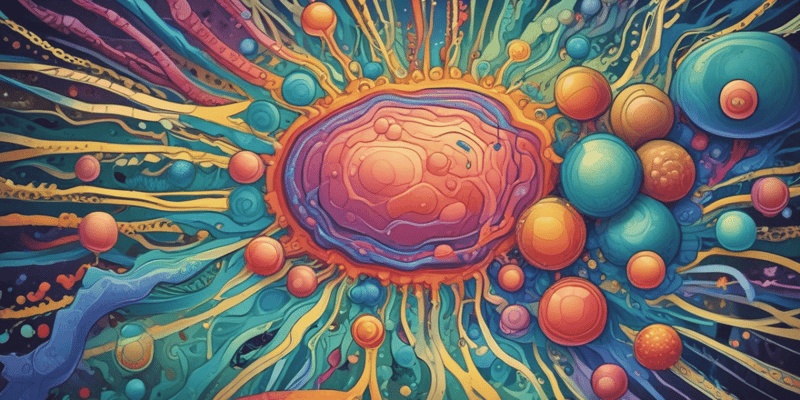20 Questions
What is a common general structure shared by all biological membranes?
A thin film of lipid and protein molecules
What is the primary function of the plasma membrane?
To define the cell's boundaries and maintain differences between the cytosol and extracellular environment
What is the role of ion gradients across membranes?
To synthesize ATP, drive the transport of selected solutes, or produce and transmit electrical signals
What percentage of proteins encoded in an animal's genome are estimated to be membrane proteins?
30%
What is the main function of transmembrane proteins that serve as structural links in the plasma membrane?
To connect the cytoskeleton through the lipid bilayer to either the extracellular matrix or an adjacent cell
What is the characteristic of the lipid molecules in the lipid bilayer?
They are arranged as a continuous double layer
What is a characteristic of the lipid molecules in cell membranes?
They have a hydrophilic or polar end and a hydrophobic or nonpolar end
What is the function of membrane proteins?
To mediate nearly all of the other functions of the membrane
What is the effect of cis-double bonds in the fatty acid tails of phospholipids?
They create a kink in the tail
What is the approximate percentage of lipid molecules in the mass of most animal cell membranes?
50%
What is the backbone of phosphoglycerides?
Glycerol
Which of the following phospholipids has a fatty acid tail attached to the amino group and a phosphocholine group attached to the terminal hydroxyl group?
Sphingomyelin
What is the function of cholesterol in eukaryotic plasma membranes?
To maintain the structure of the membrane
What is the difference between sphingolipids and glycolipids?
Sphingolipids have a phosphate-linked head group, while glycolipids do not.
What is the approximate ratio of cholesterol molecules to phospholipid molecules in eukaryotic plasma membranes?
One molecule of cholesterol for every phospholipid molecule
What is the characteristic of glycolipid distribution in plasma membranes?
They are found exclusively in the monolayer facing away from the cytosol
What is the approximate percentage of glycolipid molecules in the outer monolayer of eukaryotic cell plasma membranes?
5%
What is the reason why phospholipid molecules form bilayers spontaneously in aqueous environments?
Their shape and amphiphilic nature cause them to form bilayers
What is the characteristic of lipid molecules in a lipid bilayer?
They are able to diffuse freely within the plane of the bilayer
What is the functional importance of lipid asymmetry in plasma membranes?
It is important for converting extracellular signals into intracellular ones
Study Notes
Cell Membrane Structure and Functions
- Cell membranes have a common general structure, consisting of a thin film of lipid and protein molecules held together by noncovalent interactions.
- Cell membranes are crucial to the life of the cell, enclosing the cell, defining its boundaries, and maintaining essential differences between the cytosol and the extracellular environment.
- Inside eukaryotic cells, membranes of organelles maintain characteristic differences between their contents and the cytosol.
- Ion gradients across membranes can be used to synthesize ATP, drive transport of solutes, or produce and transmit electrical signals.
Dynamic and Fluid Structure
- Cell membranes are dynamic and fluid structures, with most of their molecules able to move about in the plane of the membrane.
- The lipid bilayer provides the basic fluid structure of the membrane and serves as a relatively impermeable barrier to the passage of most water-soluble molecules.
- Most membrane proteins span the lipid bilayer and mediate nearly all of the other functions of the membrane.
Lipid Bilayer
- The lipid bilayer provides the basic structure for all cell membranes.
- Lipid molecules constitute about 50% of the mass of most animal cell membranes, with the remainder being protein.
- All lipid molecules in cell membranes are amphiphilic, with a hydrophilic (polar) end and a hydrophobic (nonpolar) end.
Phospholipids
- Phospholipids are the most abundant membrane lipids, with a polar head group containing a phosphate group and two hydrophobic hydrocarbon tails.
- The tails can differ in length (usually 14-24 carbon atoms) and saturation (one or more cis-double bonds).
- Each cis-double bond creates a kink in the tail, influencing how phospholipid molecules pack against each other and affecting the fluidity of the membrane.
Phosphoglycerides
- Phosphoglycerides are the main phospholipids in most animal cell membranes, with a three-carbon glycerol backbone.
- Two long-chain fatty acids are linked through ester bonds to adjacent carbon atoms of the glycerol, and the third carbon atom is attached to a phosphate group.
- Phosphatidylethanolamine, phosphatidylserine, and phosphatidylcholine are the most abundant phosphoglycerides in mammalian cell membranes.
Sphingolipids
- Sphingolipids are another important class of phospholipids, built from sphingosine rather than glycerol.
- Sphingomyelin is the most common sphingolipid, with a fatty acid tail attached to the amino group and a phosphocholine group attached to the terminal hydroxyl group.
Cholesterol and Glycolipids
- Cholesterol is a sterol found in large amounts in eukaryotic plasma membranes, orienting itself with its hydroxyl group close to the polar head groups of adjacent phospholipid molecules.
- Glycolipids are sugar-containing lipid molecules found on the surface of all eukaryotic plasma membranes, with the most extreme asymmetry in their membrane distribution.
- Glycolipids probably occur in all eukaryotic cell plasma membranes, constituting about 5% of the lipid molecules in the outer monolayer.
Lipid Bilayer Formation and Properties
- The shape and amphiphilic nature of phospholipid molecules cause them to form bilayers spontaneously in aqueous environments.
- Phospholipid molecules can form either spherical micelles or double-layered sheets (bilayers) depending on their shape.
- The lipid bilayer is a two-dimensional fluid, with individual lipid molecules able to diffuse freely within the plane of the bilayer.
Learn about the structure and functions of cell membranes, including their composition and importance in maintaining cellular boundaries and differences.
Make Your Own Quizzes and Flashcards
Convert your notes into interactive study material.
Get started for free



